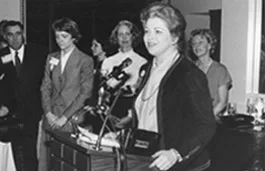 By Joy Lutes, NAWBO National vice president of external affairs
By Joy Lutes, NAWBO National vice president of external affairs
As originally featured in Greater Phoenix InBusiness
Landmark legislation that opened doors dates back only 30 years
Thirty years ago, some U.S. states had laws that precluded women from obtaining a business loan without a male relative to cosign for them—even if that male were an underage son.
The National Women’s Business Council, which does research into the women’s business ecosystem, and the Women’s Business Centers, managed by the U.S. Small Business Administration, did not exist.
Additionally, the U.S. Census was not collecting data from woman-owned C corporations, and therefore, there was a common misconception that most woman-owned businesses were very small or the women were simply self-employed.
 Thankfully, a group of women, including some leaders from NAWBO, worked with elected officials in Washington, DC to address those issues and remove those obstacles to women business owners. The legislation that resulted, commonly known as H.R. 5050 but formally titled the Women’s Business Ownership Act, turns 30 years old this year. It established programs and initiated efforts to assist the development of small businesses owned and controlled by women.
Thankfully, a group of women, including some leaders from NAWBO, worked with elected officials in Washington, DC to address those issues and remove those obstacles to women business owners. The legislation that resulted, commonly known as H.R. 5050 but formally titled the Women’s Business Ownership Act, turns 30 years old this year. It established programs and initiated efforts to assist the development of small businesses owned and controlled by women.
Thirty years since the passage of H.R. 5050, too many women business owners still encounter difficulties accessing the capital they need to start or scale their businesses. The 2012 annual report from the National Women’s Business Council demonstrates there is a need to get more money into the hands of women entrepreneurs. Among the key findings were that, on average, men start their businesses with nearly twice as much capital as women ($135,000 vs. $75,000). This disparity is slightly larger among firms with high-growth potential ($320,000 vs. $150,000), and much larger in the Top 25 firms ($1.3 million vs. $210,000).
Despite the obstacles they face, women’s ownership of businesses continues to grow. According to the 2017 State of Women-Owned Businesses Report commissioned by American Express, women’s entrepreneurship has been rising in the United States for the last two decades, growing as much as 114 percent. These statistics come during times when woman-led companies comprised a little less than 5 percent of all venture capital (VC) deals, received a little more than 2 percent of all VC dollars and received approximately 4 percent of all commercial loan dollars.
Today, according to the U.S. Small Business Administration, the Women’s Business Centers represent a national network of more than 100 educational centers throughout the United States and its territories, which are designed to assist women in starting and growing small businesses.
While research into women business owners has expanded and improved, additional data is always helpful in driving good and sound public policy. The 30th anniversary of this landmark legislation provides an opportunity to assess how far women business owners have come and how we can work together to support their success moving forward.
Landmark Legislation
H.R. 5050, authored by U.S. Representative John LaFalce (D – NY), was signed into law by President Ronald Reagan on October 25, 1988.
Capital and Employment
|
5%: |
The federal government’s spending goal for procurement contracts to woman-owned businesses (part of the 23 percent it strives to award to small businesses) |
|
FY 2015: |
The only year the federal government achieved its procurement-contract goal, as of FY 2017 |
|
4%: |
The amount of commercial loan dollars that go to women-owned businesses (in 2017) |
|
2%: |
The amount of VC loan dollars that go to women-owned businesses (in 2017) |
|
600,000: |
The number of jobs researchers estimate women-owned businesses would create in five years if women started their businesses with the same amount of money as men |
Growing Numbers
|
26% to 57%: |
Growth from 1992 (four years after passage of HR 5050) to 2002 of women-owned businesses in the U.S. |
|
1.5 million: |
The number of businesses owned by black women in 2012 (the most recent year surveyed), an increase of 66 percent over 2007 |
|
1.4 million: |
The number of businesses owned by Latina women in 2012, an increase of 87 percent over 2007 |
|
749,197: |
The number of businesses owned by Asian women in 2012, an increase of 43 percent over 2007 |
Source: “Spotlight on H.R. 5050” white paper from NAWBO and GovTrack
To view the original article, click here.

